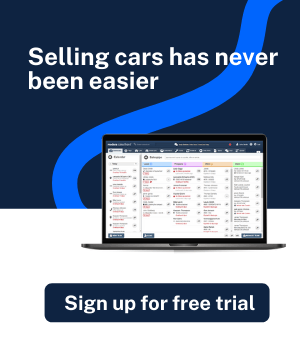
With car selling becoming a more complex process, especially after the Covid-19 pandemic, dealerships are opting to use a DMS. (dealership management software or dealership management system). They are doing that in order to run their operations in a hassle-free manner. It comes with a host of features such as inventory management, service scheduling, deal structuring, reporting tools, and much more.
What is the function of a DMS?
Dealership management systems enable a dealership to perform day-to-day functions such as sales operations, financing operations, service operations and more. It is imperative that every aspect of a dealership work together. Dealers can improve each facet of their business, by combining the tools required into a single platform. That all with a dealership management system.
When all daily transactions of the dealership encounters are combined under one unit, you can run the business seamlessly. No longer do you need to log-in to separate solutions to manage your inventory. Or create point of sale invoices, view service history or follow-up on leads.
Using the software integrations available with a DMS, dealers can manage their entire business in one cloud-based dealership software application. Thus, business owners can easily monitor all dealership related operations and keep an eye on everything. Integrations built into the software allows for a more streamline, easy-to-use exchange of information. And between all the operational areas of your dealership running through your software.

A dealership management system helps to achieve your goals by creating an effective and cooperative way for departments to communicate. Or interact and stay informed with transactions happening within other areas of the dealership. A good DMS helps to save money and improve the efficiency of your business operations, while enhancing customer experience at your dealership too.
What is agency sales model?
The agency model combines OEM steered online sales with conventional retail sales – it is an excellent balancing act. It optimally utilizes existing dealer infrastructures and digital sales to guarantee benefits for all parties involved. Agency model also lets OEMs achieve a 360-degree view of the customer. It even means lower costs associated with sales and newer revenue streams. Thus, OEMs can adopt a target-centric approach and opt for transparent reporting.
What is the direct-to-consumer model?
It can’t be denied that the Covid-19 pandemic has shifted consumer behaviors and attitudes as social distancing and safety concerns persist, even if the automotive industry is gradually limping back to normalcy. Most consumers wish to search for and purchase cars online rather than visit dealerships. In fact, this trend was already brewing before the pandemic.
However, it has accelerated now that contactless experiences are prevalent. But OEMs have to adhere to certain legal requirements that prevent them from selling directly to consumers. However, they can capitalize on this model by selling aftermarket parts, which offers big margins and comes directly from the manufacturer. OEM-s can offer end-user services related to data connectivity. Or insurance may provide other possibilities, and replicate showrooms and sales interactions online.
How can DMS help OEMs in their business for both models?

As mentioned, the automotive industry is gradually stabilizing, but a lot of work still has to be done. Dealers are gathering truckloads of useful data about customers, but the full value of that information often remains underused. It occurs due to lack of advanced analytics and insights. Moreover, the lack of robust collaboration between OEMs and dealers often results in fragmented lead management and inconsistencies in the customer experience, making it difficult to deliver personalized marketing at scale.
A DMS connects OEMs and dealer touchpoints across the entire customer lifecycle that can help both parties in two ways:
- Enabling more effective lead management and customer acquisition.
- Facilitating coordinated, responsive, and personalized marketing at scale that impacts sales, service and financing.
Better lead acquisition and management means a boost in conversion rates
When you understand buyer behavior more clearly, it can help tailor customer interactions to improve lead acquisition and nurturing. It ultimately turns unknown customers into promising leads. A deeper dive into the information can lead to more actionable and effectively targeted recommendations unified across all channels.
Stronger OEM and dealer collaboration can also enhance lead generation for sales and after-sales by using customer analytics to tailor the content and timing of marketing and sales outreach. For instance, OEMs can share the most accurate product, pricing, and inventory information with dealers. And if done regularly it helps to prevent miscommunication and satisfy customer expectations. Further insight into lead sources can help OEMs and dealers align on customer engagement strategies. And also coordinate consistent sales and service communications. Eventually it impacts your lead acquisition, and conversion rates.
OEMs and dealerships can come up with service intervention campaigns, which combine sales and service teams. With insights from electronic vehicle health data, vehicle repair codes and parts supply, both parties can drive greater after-sales retention revenue and spend-per-unit in operation.
Launch coordinated, responsive, and automated marketing campaigns
A shared 360-degree view of each customer enables OEMs and dealers to create consistent and personalized customer journeys. This “journey” can be created across every channel whether the customer interacts with the dealer or the OEM. Coordinated marketing efforts, from messaging to outreach, will work to engage customers, minimize miscommunications, and increase trust and loyalty.

Service communications benefit from this holistic customer view, too. With automated and personalized customer engagement at scale, campaigns throughout the ownership lifecycle, and in-car service reminders, OEMs and dealers can streamline productivity, build customer loyalty and increase service center revenue. This coordination streamlines all efforts, but it also ensures that any investments in engagement are more effective and efficient than ever before.
Customers want to engage with a dealership that understands their requirements, which requires collaboration between OEMs and dealers. That is why you have to invest in a Dealership management system ASAP!

